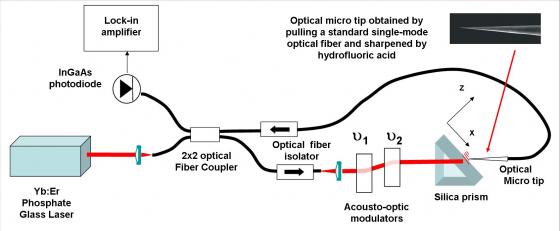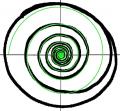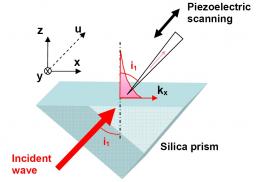

The SNOM (Scanning Near-field Optical Microscopy) allows to reach a spatial resolution well below the wavelength of the light used. Indeed, thanks to the "near-field" illumination (when the distance between the object and the source is much less than the wavelength) it becomes possible to avoid the diffraction inherent to every optical system. Measurement of the evanescent field at the back side of a total-reflection interface allows obtaining a SNOM image with a resolution well below one micrometer.
A new very sensitive method of measurement of this type has been proposed and patented by the team "Lasers, and Optical Instrumentation Applications" team within CIMAP (ex CIRIL) in Caen. Its principle is based on the "optical heterodyn retro-injection in a Class B laser". In this type of laser, the re-injection of the wave slightly shifted in frequency (ν0+Δν), with respect to the initial laser frequency ν0, disrupt dynamically the laser emission. A modulation of the amplitude of the laser light, at a frequency Δν, results. At resonance with the natural frequency Δνr of the relaxation of the laser emission (Δν = Δνr), the laser light modulation is highly amplified and easily observable by synchronous detection (detection gain: 106 !). This provides a highly sensitive detection chain of the optical signal at the frequency Δνr.

Experimental device: The evanescent wave at the frequency (ν0+ν1-ν2 captured by the tip is re-injected into the laser (frequency ν0). The resulting modulation of the amplitude of the laser emission is easily measured by synchronous detection. After this amplification, we then get a highly sensitive measurement of the amplitude and phase of the evanescent wave.

Amplitude and phase of the evanescent wave measured with the method, during a backward displacement of the tip from the surface of the prism.
Two acousto-optic modulators (frequency ν1 et ν2) allow, by mixing with the exciting laser frequency, to generate a beam at the required frequency (ν0+ν1-ν2 = ν0+Δνr). This wave is sent to the rear of a prism in a position for total reflection.
The measurement principle is then extracting a portion of the evanescent field formed on the surface of the studied sample by using an optical micro-tip (a tapered and stretched by etching optical fiber). The very weak signal obtained is injected into the laser where it is amplified and detected. The analysis of the signal allows a local measurement of the amplitude and the phase of the evanescent field. By scanning the tip, a SNOM image in amplitude and phase is finally obtained.
A first experiment has been performed with a solid laser glass Yb: Er, emitting at 1.53 µm. The adjacent figure shows the measured simultaneous evolution of the amplitude and the phase of the evanescent field when the micro-tip is moved away from the surface.
Several applications of the SNOM microscopy are concerned by this original an performing technique. Some examples are the characterization of integrated optoelectronic and telecom components, or the study of the features of micro/nano-structured components… Finally, the very high sensitivity of the method, coupled with the simultaneous measurement of the amplitude and the signal phase, is a further step towards a "new holography at the SNOM scale."
"Near field amplitude and phase measurements using heterodyne optical feedback on solid-state lasers",
H. Gilles, S. Girard, M. Laroche, A. Belarouci , Optics Letters 33(1) (2008) 1.
""Heterodyne detection device for imaging an object by retro-injection""
S. Girard, H. Gilles, M. Laroche, Patent n°101377-FR













 Laser-matter interaction
Laser-matter interaction